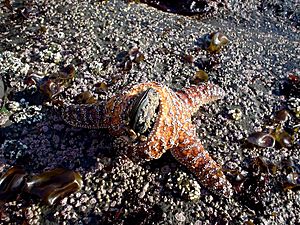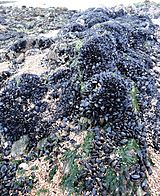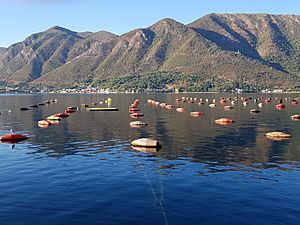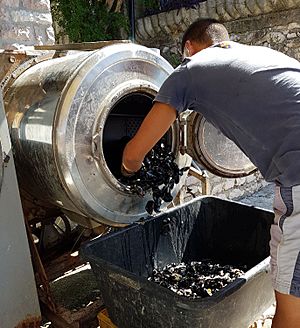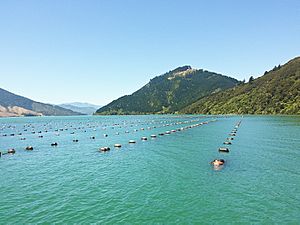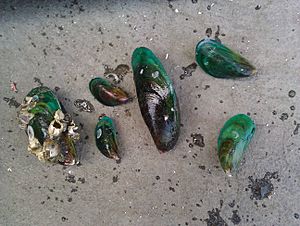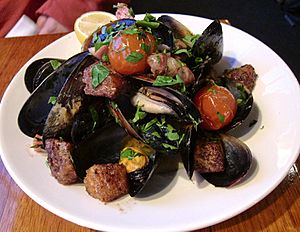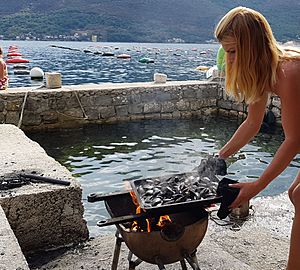Mussel facts for kids
Quick facts for kids Mussel |
|
|---|---|
 |
|
| Mussels | |
| Scientific classification | |
| Kingdom: | |
| Phylum: | |
| Class: | |
| Subclasses | |
|
Pteriomorpha (marine mussels) |
|
Mussels are several families of bivalve molluscs. Mussels live in lakes, rivers, and creeks. They sometimes also live in intertidal areas along coastlines worldwide.
The freshwater mussels and saltwater mussels are not closely related, despite the fact that they may look similar. They are grouped in different subclasses.
The freshwater Zebra mussels and their relatives (family Dreissenidae) live attached to rocks in a manner similar to marine mussels, but are classified with the Heterodonta, the taxonomic group including most bivalves referred to as "clams".
Humans have been eating mussels for thousands of years. They can be cooked or eaten raw. Care must be taken however as mussels quickly become poisonous after they die.
Contents
General anatomy
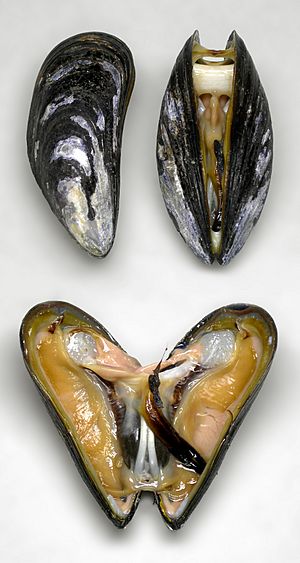
The mussel's external shell is composed of two hinged halves or "valves". The valves are joined together on the outside by a ligament, and are closed when necessary by strong internal muscles. Mussel shells carry out a variety of functions, including support for soft tissues, protection from predators and protection against desiccation.
The shell has three layers.
Like most bivalves, mussels have a large organ called a foot. In freshwater mussels, the foot is large, muscular, and generally hatchet-shaped. It is used to pull the animal through sand, gravel, or silt in which it lies partially buried. It does this by repeatedly advancing the foot through the sand, expanding the end so it serves as an anchor, and then pulling the rest of the animal with its shell forward. It also serves as a fleshy anchor when the animal is stationary.
In marine mussels, the foot is smaller, tongue-like in shape, with a groove on the ventral surface which is continuous with the byssus pit.
The byssal thread is also sometimes used by mussels as a defensive measure, to tether predatory molluscs, such as dog whelks, that invade mussel beds, immobilising them and thus starving them to death.
In cooking, the byssus of the mussel is known as the "beard" and is removed before the mussels are prepared.
Life habits
Feeding
Both marine and freshwater mussels are filter feeders; they feed on plankton and other microscopic sea creatures which are free-floating in seawater.
Marine mussels are usually found clumping together on wave-washed rocks, each attached to the rock by its byssus. The clumping habit helps hold the mussels firm against the force of the waves. At low tide mussels in the middle of a clump will undergo less water loss because of water capture by the other mussels.
Reproduction
Both marine and freshwater mussels are gonochoristic, with separate male and female individuals. In marine mussels, fertilization occurs outside the body, with a larval stage that drifts for three weeks to six months, before settling on a hard surface as a young mussel. There, it is capable of moving slowly by means of attaching and detaching byssal threads to attain a better life position.
Freshwater mussels reproduce sexually. Sperm is released by the male directly into the water and enters the female via the incurrent siphon. After fertilization, the eggs develop into a larval stage called a glochidium (plural glochidia), which temporarily parasitizes fish, attaching themselves to the fish's fins or gills. Prior to their release, the glochidia grow in the gills of the female mussel where they are constantly flushed with oxygen-rich water.
Glochidia are generally species-specific, and will only live if they find the correct fish host. Once the larval mussels attach to the fish, the fish body reacts to cover them with cells forming a cyst, where the glochidia remain for two to five weeks (depending on temperature). They grow, break free from the host, and drop to the bottom of the water to begin an independent life.
Predators
Marine mussels are eaten by humans, starfish, seabirds, and by numerous species of predatory marine gastropods in the family Muricidae, such as the dog whelk, Nucella lapillus. Freshwater mussels are eaten by otters, raccoons, ducks, baboons, humans, and geese.
Distribution and habitat
Marine mussels are abundant in the low and mid intertidal zone in temperate seas globally. Other species of marine mussel live in tropical intertidal areas, but not in the same huge numbers as in temperate zones.
Certain species of marine mussels prefer salt marshes or quiet bays, while others thrive in pounding surf, completely covering wave-washed rocks. Some species have colonized abyssal depths near hydrothermal vents. The South African white mussel exceptionally doesn't bind itself to rocks but burrows into sandy beaches extending two tubes above the sand surface for ingestion of food and water and exhausting wastes.
Freshwater mussels inhabit permanent lakes, rivers, canals and streams throughout the world except in the polar regions. They require a constant source of cool, clean water. They prefer water with a substantial mineral content, using calcium carbonate to build their shells.
Aquaculture
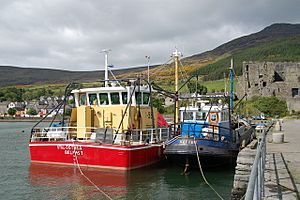
In 2005, China accounted for 40% of the global mussel catch according to a FAO study. Within Europe, where mussels have been cultivated for centuries, Spain remained the industry leader. Aquaculture of mussels in North America began in the 1970s. In the US, the northeast and northwest have significant mussel aquaculture operations, where Mytilus edulis (blue mussel) is most commonly grown. While the mussel industry in the US has increased, in North America, 80% of cultured mussels are produced in Prince Edward Island in Canada. In Washington State, an estimated 2.9M pounds of mussels were harvested in 2010, valued at roughly $4.3M.
Culture methods
Freshwater mussels are used as host animals for the cultivation of freshwater pearls. Some species of marine mussel, including the Blue mussel (Mytilus edulis) and the New Zealand green-lipped mussel (Perna canaliculus), are also cultivated as a source of food.
In some areas of the world, mussel farmers collect naturally occurring marine mussel seed for transfer to more appropriate growing areas, however, most North American mussel farmers rely on hatchery-produced seed.
Growers typically purchase seed after it has set (about 1mm in size) or after it has been nursed in upwellers for 3-6 additional weeks and is 2-3mm. The seed is then typically reared in a nursery environment, where it is transferred to a material with a suitable surface for later relocation to the growing area. After about three months in the nursery, mussel seed is "socked" (placed in a tube-like mesh material) and hung on longlines or rafts for grow-out.
Within a few days, the mussels migrate to the outside of the sock for better access food sources in the water column. Mussels grow quickly and are usually ready for harvest in less than two years. Unlike other cultured bivalves, mussels use byssus threads (beard) to attach themselves to any firm substrate, which makes them suitable for a number of culture methods.
There are a variety of techniques for growing mussels.
- Bouchot culture: bouchots, are planted at sea; ropes, on which the mussels grow, are tied in a spiral on the pilings; some mesh netting prevents the mussels from falling away. This method needs an extended tidal zone.
- On-bottom culture: On-bottom culture is based on the principle of transferring mussel seed (spat) from areas where they have settled naturally to areas where they can be placed in lower densities to increase growth rates, facilitate harvest, and control predation (Mussel farmers must remove predators and macroalgae during the growth cycle).
- Raft culture: Raft culture is a commonly used method throughout the world. Lines of rope mesh socks are seeded with young mussels and suspended vertically from a raft. The specific length of the socks depends on depth and food availability.
- Longline culture (rope culture): Mussels are cultivated extensively in New Zealand, where the most common method is to attach mussels to ropes which are hung from a rope back-bone supported by large plastic floats. The most common species cultivated in New Zealand is the New Zealand green-lipped mussel. Longline culture is the most recent development for mussel culture and are often used as an alternative to raft culture in areas that are more exposed to high wave energy. A long-line is suspended by a series of small anchored floats and ropes or socks of mussels are then suspended vertically from the line.
Harvest
In roughly 12–15 months, mussels reach marketable size (40mm) and are ready for harvest. Harvesting methods depend on the grow-out area and the rearing method being used.
Dredges are currently used for on-bottom culture. Mussels grown on wooden poles can be harvested by hand or with a hydraulic powered system. For raft and longline culture, a platform is typically lowered under the mussel lines, which are then cut from the system and brought to the surface and dumped into containers on a nearby vessel. After harvest, mussels are typically placed in seawater tanks to rid them of impurities before marketing.
Medical
Byssal threads, used to anchor mussels to substrates, are now recognized as superior bonding agents. A number of studies have investigated mussel "glues" for industrial and surgical applications.
Additionally byssal threads have provided insight into the construction of artificial tendons.
Environmental applications
Mussels are widely used as bio-indicators to monitor the health of aquatic environments in both fresh water and the marine environments.
Conservation
Freshwater Mussels
In the United States and Canada, areas home to the most diverse freshwater mussel fauna in the world, there are 297 known freshwater mussel taxa. Of the 297 known species, 213 (71.7%) taxa are listed as endangered, threatened, of special concern. The main factors contributing to the decline of freshwater mussels include destruction from dams, increased siltation, channel modification, and the introduction of invasive species like the Zebra mussel.
As food
Humans have used mussels as food for thousands of years. About 17 species are edible, of which the most commonly eaten are Mytilus edulis, M. galloprovincialis, M. trossellus and Perna canaliculus.
Freshwater mussels are generally considered to be unpalatable and are almost entirely not consumed, although the native peoples of North America ate them extensively and still do today.
In the USA during the Second World War, mussels were commonly served in diners and eateries across the country. This was due to the lack of access to red meat (such as beef and pork) for the general public, in relation to the aspect of the American wartime rationing policy concerning food, with much of the meat available being sent to aid the US military's war efforts abroad. Instead, mussels became a popular substitute for most meats (with the exception of chicken).
In Belgium, the Netherlands, and France, mussels are consumed with French fries ("mosselen met friet" or "moules-frites") or bread. In Belgium, mussels are sometimes served with fresh herbs and flavorful vegetables in a stock of butter and white wine. Fries and Belgian beer sometimes are accompaniments. In the Netherlands, mussels are sometimes served fried in batter or breadcrumbs, particularly at take-out food outlets or informal settings. In France, the Éclade des Moules, or, locally, Terré de Moules, is a mussel bake that can be found along the beaches of the Bay of Biscay.
In Italy, mussels are mixed with other sea food, they are consumed often steam cooked (most popular), sometimes with white wine, herbs, and served with the remaining water and some lemon. In Spain, they are consumed mostly steam cooked, sometimes boiling white wine, onion and herbs, and served with the remaining water and some lemon. They can also be eaten as "tigres", a sort of croquette using the mussel meat, shrimps and other pieces of fish in a thick bechamel then breaded and fried in the clean mussel shell. They are used in other sort of dishes such as rices or soups or commonly eaten canned in a pickling brine made of oil, vinegar, peppercorns, bay leaves and paprika.
In Turkey, mussels are either covered with flour and fried on shishs ('midye tava'), or filled with rice and served cold ('midye dolma') and are usually consumed after alcohol (mostly raki or beer).
They are used in Ireland boiled and seasoned with vinegar, with the "bray" or boiling water as a supplementary hot drink.
In Cantonese cuisine, mussels are cooked in a broth of garlic and fermented black bean.
In New Zealand, they are served in a chili or garlic-based vinaigrette, processed into fritters and fried, or used as the base for a chowder.
In India, mussels are popular in Kerala, Maharashtra, Karnataka-Bhatkal, and Goa. They are either prepared with drumsticks, breadfruit or other vegetables, or filled with rice and coconut paste with spices and served hot. Fried mussels ('Kadukka' കടുക്ക in Malayalam) of north Kerala especially in Thalassery are a spicy, favored delicacy. In coastal Karnataka Beary's prepare special rice ball stuffed with spicy fried mussels and steamed locally known as "pachilede pindi".
Preparation
Mussels can be smoked, boiled, steamed, roasted, barbecued or fried in butter or vegetable oil. As with all shellfish, except shrimp, mussels should be checked to ensure they are still alive just before they are cooked; enzymes quickly break down the meat and make them unpalatable or poisonous after dying or uncooked. Some mussels might contain toxins. A simple criterion is that live mussels, when in the air, will shut tightly when disturbed. Open, unresponsive mussels are dead, and must be discarded. Unusually heavy, wild-caught, closed mussels may be discarded as they may contain only mud or sand. (They can be tested by slightly opening the shell halves.) A thorough rinse in water and removal of "the beard" is suggested.
Mussel shells usually open when cooked, revealing the cooked soft parts.
Although mussels are valued as food, mussel poisoning due to toxic planktonic organisms can be a danger along some coastlines.



